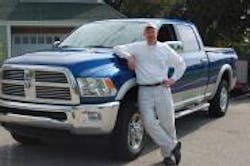I got a rare opportunity this past July, to serve as judge and “test driver for Ward’s, Fleet Owner’s sister publication, when its editors decided to expand their well-established “Ten Best Engines” competition by holding the magazine’s first-ever “Best Engines Diesel Shootout.”
The competition pitted a Cummins 6.7 liter diesel I-6 powering a Ram Laramie 2500 HD pickup, Duramax 6.6 liter diesel V-8 in a GMC Sierra Denali HD pickup, and the new Power Stroke 6.7 liter diesel V-8 in a Ford F-250 Super Duty Lariat pickup in a three-way battle to see which diesel model stood apart from the rest.
Needless to say, this wasn’t easy, for they all produced horsepower, torque, and fuel economy metrics that would appeal to any commercial fleet, much less the everyday consumer.
The testing, conducted at Robert Bosch LLC‘s test track in Flat Rock, MI, as well as on public roadways in and around Detroit on July 28 this year, also focused on the finer points of the “diesel driving experience,” as to which model produced a more pleasing sound, handled better in both rapid acceleration situations as well as “ho-hum” driving conditions on the open road.
Now, I THOUGHT the highway part of the testing – a long hour’s drive from Flat Rock north to General Motor’s providing grounds outside of Milford, MI – would produce the “ho-hum” part of the overall testing experience. Boy was I WRONG! As you can see below, the weather turned wretched, giving me some white knuckle moments here and there.
[It’s also very apparent that my subconscious STILL has NOT gotten around to recognizing that Chrysler dropped the “Dodge” name from its Ram Truck line almost a year ago. So you’ll hear “Dodge Ram” more than once in this clip. What can I say? Old nomenclature dies hard in my memory banks.]
Now, the really “fun stuff” took place on Bosch’s test track – a facility built back in 1990 to predominantly test light-duty vehicles. Jim Glutting is the guy in charge of the place, and let me tell you, he knows his stuff. He’s got four “high performance” drivers on his staff that can run rings around just about anyone (me included), but they graciously acted as co-pilots on this adventure, telling us how to hit the corners, when to accelerate and when to brake, etc.
“Our performance drivers notice the fine nuances in vehicle behavior,” Glutting told me (seen here wearing a white shirt in the photo at right, giving some tips to Ward's editor Eric Mayne). “They work closely with engineers to help make all sorts of light duty systems function at their best.”
Now, of course, you can’t recreate the “real world” on a test track, which is why Bosch also maintains a “winter test site” up in Minnesota, complete with a 450-foot wide by 1,800-foot long “snow/ice circle” to put vehicles through the most rigorous winter testing possible.
At Flat Rock, most of the testing focuses on traction control, electronic stability programs (ESP), and trailer sway control to make sure all the electronics managing these critical safety systems function properly.
In fact, Bosch’s proving grounds in Flat Rock, went through an $8 million upgrade and expansion two years ago, which included the addition of a roughly 10,000-square foot main building that houses three maintenance bays for vehicle work, a wash bay, and of course plenty of conference rooms and office space for the engineering work that goes on the track.
Bosch also expanded its facility from eight to 21 acres as well, adding a vehicle dynamic area (VDA) to expand upon its light-duty testing capability. All told, about 30 people a day are working at the Flat Rock facility, testing everything from sports coups and sedans to a wide variety of light trucks.
Using the test track in combination with drives on public roads also helped balance out a lot of “perceptions” when it came to rating vehicle performance during our test day, too – for it’s one thing to log acceleration numbers on a closed course; quite another to sweat out a zero-to-highway-speed merge from a gravel lot while towing 10,000-pounds. That puts grey hairs in one’s beard right quick (and my beard is now full of them!)
All in all, it proved quite an interesting experience, testing three diesel-powered pickups head-to-head in this fashion. Hopefully, it’ll give you some more information to ponder if and when you consider what diesel pickup to buy down the road.
